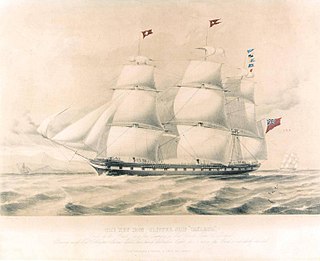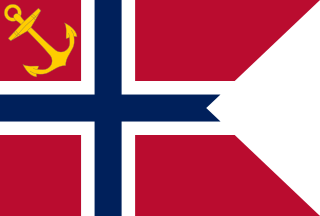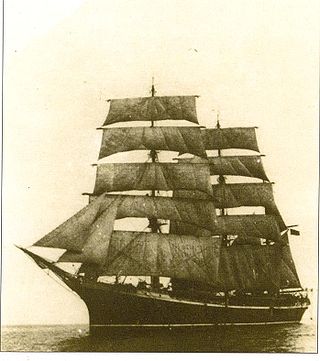Related Research Articles

A brig is a type of sailing vessel defined by its rig: two masts which are both square-rigged. Brigs originated in the second half of the 18th century and were a common type of smaller merchant vessel or warship from then until the latter part of the 19th century. In commercial use, they were gradually replaced by fore-and-aft rigged vessels such as schooners, as owners sought to reduce crew costs by having rigs that could be handled by fewer men. In Royal Navy use, brigs were retained for training use when the battle fleets consisted almost entirely of iron-hulled steamships.

Impressment, colloquially "the press" or the "press gang", is a type of conscription of people into a military force, especially a naval force, via intimidation and physical coercion, conducted by an organized group. European navies of several nations used impressment by various means. The large size of the British Royal Navy in the Age of Sail meant impressment was most commonly associated with Great Britain and Ireland. It was used by the Royal Navy in wartime, beginning in 1664 and during the 18th and early 19th centuries as a means of crewing warships, although legal sanction for the practice can be traced back to the time of Edward I of England. The Royal Navy impressed many merchant sailors, as well as some sailors from other, mostly European, nations. People liable to impressment were "eligible men of seafaring habits between the ages of 18 and 55 years". Non-seamen were sometimes impressed as well, though rarely. In addition to the Royal Navy's use of impressment, the British Army also experimented with impressment from 1778 to 1780.
Prize money refers in particular to naval prize money, usually arising in naval warfare, but also in other circumstances. It was a monetary reward paid in accordance with the prize law of a belligerent state to the crew of a ship belonging to the state, either a warship of its navy or a privateer vessel commissioned by the state. Prize money was most frequently awarded for the capture of enemy ships or of cargoes belonging to an enemy in time of war, either arrested in port at the outbreak of war or captured during the war in international waters or other waters not the territorial waters of a neutral state. Goods carried in neutral ships that are classed as contraband, being shipped to enemy-controlled territory and liable to be useful to it for making war, were also liable to be taken as prizes, but non-contraband goods belonging to neutrals were not. Claims for the award of prize money were usually heard in a prize court, which had to adjudicate the claim and condemn the prize before any distribution of cash or goods could be made to the captors.

A liberty pole is a wooden pole, or sometimes spear or lance, surmounted by a "cap of liberty", mostly of the Phrygian cap. The symbol originated in the immediate aftermath of the assassination of the Roman dictator Julius Caesar by a group of Rome's Senators in 44 BCE. Immediately after Caesar was killed the assassins, or Liberatores as they called themselves, went through the streets with their bloody weapons held up, one carrying a pileus carried on the tip of a spear. This symbolized that the Roman people had been freed from the rule of Caesar, which the assassins claimed had become a tyranny because it overstepped the authority of the Senate and thus betrayed the Republic.

RMS Tayleur was a short-lived, full-rigged iron clipper ship chartered by the White Star Line. She was large, fast and technically advanced. She ran aground off Lambay Island and sank, on her maiden voyage, in 1854. Of more than 650 aboard, only 280 survived. She has been described as "the first Titanic".

The Norwegian Shipping and Trade Mission (Nortraship) was established in London in April 1940 to administer the Norwegian merchant fleet outside German-controlled areas. Nortraship operated some 1,000 vessels and was the largest shipping company in the world. It made a major contribution to the Allied war effort.

The first USS Randolph was a 32-gun frigate in the Continental Navy named for Founding Father Peyton Randolph, the president of the First Continental Congress. Attaining only moderate success in her career, Randolph was destroyed by an explosion of her gunpowder stores during a naval action on 8 March 1778.

The Pennsylvania Navy served as the naval force of Pennsylvania during the American Revolution and afterward, until the formation of the United States Navy. The navy's vessels served almost exclusively on the Delaware River, and were active in first defending the approaches to the city of Philadelphia during the British campaign that successfully occupied the city in 1777, and then preventing the Royal Navy from resupplying the occupying army.

Suomen Joutsen is a steel-hulled full-rigged ship with three square rigged masts. Built in 1902 by Chantiers de Penhoët in St. Nazaire, France, as Laënnec, the ship served two French owners before she was sold to German interest in 1922 and renamed Oldenburg. In 1930, she was acquired by the Government of Finland, refitted to serve as a school ship for the Finnish Navy and given her current name. Suomen Joutsen made eight long international voyages before the Second World War and later served in various support and supply roles during the war. From 1961 on she served as a stationary seamen's school for the Finnish Merchant Navy. In 1991, Suomen Joutsen was donated to the city of Turku and became a museum ship moored next to Forum Marinum.

Slave ships were large cargo ships specially built or converted from the 17th to the 19th century for transporting slaves. Such ships were also known as "Guineamen" because the trade involved human trafficking to and from the Guinea coast in West Africa.

Glenlee is a steel-hulled three-masted barque, built as a cargo ship at Port Glasgow under that name in 1896 for Glasgow owners. With later owners she was named Islamount and Clarastella. From 1922 she was the sail training ship Galatea in the Spanish Navy. Since 1993, carrying her original name, Glenlee has been a museum ship at the Riverside Museum on Pointhouse Quay, Glasgow, known as The Tall Ship at Glasgow Harbour.
SS Audacious was the former Italian cargo ship Belvedere taken over by the United States during World War II and sunk as a blockship at Omaha Beach on 8 June 1944. Belvedere was built in Trieste and first operated as a passenger and cargo ship when the city and company were part of Austro-Hungarian Empire. After World War I the city and ship, converted to cargo in the early 1920s, became Italian. In 1941 Belvedere was in Philadelphia when foreign ships of Axis powers were interned and then seized. The ship was taken over for operation by the War Shipping Administration through agents until scuttled at Omaha Beach.
The maritime history of the United States is a broad theme within the history of the United States. As an academic subject, it crosses the boundaries of standard disciplines, focusing on understanding the United States' relationship with the oceans, seas, and major waterways of the globe. The focus is on merchant shipping, and the financing and manning of the ships. A merchant marine owned at home is not essential to an extensive foreign commerce. In fact, it may be cheaper to hire other nations to handle the carrying trade than to participate in it directly. On the other hand, there are certain advantages, particularly during time of war, which may warrant an aggressive government encouragement to the maintenance of a merchant marine.
The United States merchant marine forces matured during the maritime history of the United States (1900–1999).

The Burning of Norfolk was an incident that occurred on January 1, 1776, during the American Revolutionary War. British Royal Navy ships in the harbor of Norfolk, Virginia, began shelling the town, and landing parties came ashore to burn specific properties. The town, whose significantly Loyalist population had fled, was occupied by Patriot forces from Virginia and North Carolina. Although the Patriots worked to drive off the British landing parties, they did nothing to impede the progress of the flames, and began burning and looting Loyalist-owned property instead.
Jack Tar is a common English term that was originally used to refer to seamen of the Merchant Navy or the Royal Navy, particularly during the British Empire. By World War I the term was used as a nickname for those in the US Navy. Members of the public and seafarers alike made use of the name in identifying those who went to sea. It was not used pejoratively, and sailors were happy to use the term to label themselves.

The Callao affair occurred in November 1820, during the Peruvian War of Independence. It began when a Spanish fort opened fire on the United States warship USS Macedonian. Though the ship was damaged, the Americans did not violate their neutrality by counterattacking. On the following day, a boat filled with United States Navy sailors was attacked, resulting in the deaths of two seamen and the wounding of eight others. Two days after that, an American merchant ship was attacked and her crew had to abandon ship. Ultimately, there was no significant response by the United States to the attacks on their shipping and their citizens, though the Spanish government vowed to punish the perpetrators.
Home Office 213/926 or HO 213/926 is a Home Office file which records the secret deportation from the United Kingdom of thousands of seafarers to China in 1945 and 1946, permanently separating them from their families. It was officially entitled "Compulsory repatriation of undesirable Chinese seamen."
Friendship was launched in France or Spain, possibly in 1780. The British captured her in 1797 and she became a West Indiaman, and from 1798 a slave ship in the triangular trade in enslaved people. Friendship made two complete voyages carrying captives from West Africa to the West Indies. On her third voyage crew members mutinied, taking her before she had embarked any captives. They sailed for a French port in the Caribbean but the Royal Navy retook her in 1801 and brought her into Barbados. There the Government Agent sold her. The incident resulted in a legal dispute between the owners and the insurers that in 1813 was decided in favour of the owners. New owners in 1803 continued to sail Friendship as West Indiaman. She was last listed in 1810.

William James (1735–1798) was an English slave trader, plantation owner and slave owner.
References
- ↑ Williams, Gomer (2004). History of the Liverpool privateers and letters of marque : with an account of the Liverpool slave trade, 1744-1812. Liverpool: Liverpool University Press. ISBN 0-85323-709-3.
- Hunter, B. (2002), Forgotten Hero - The Life and Times of Edward Rushton, Living History Library. ISBN 0-9542077-0-X